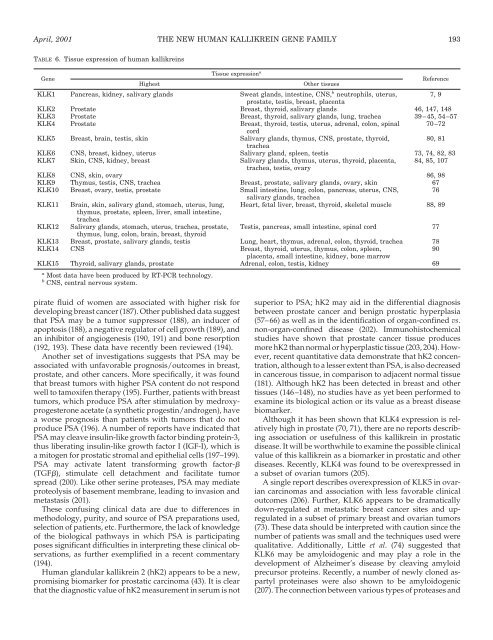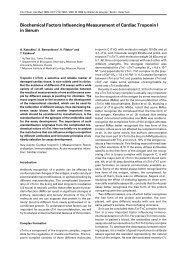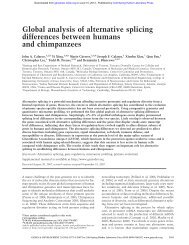The New Human Tissue Kallikrein Gene Family - Endocrine Reviews
The New Human Tissue Kallikrein Gene Family - Endocrine Reviews
The New Human Tissue Kallikrein Gene Family - Endocrine Reviews
Create successful ePaper yourself
Turn your PDF publications into a flip-book with our unique Google optimized e-Paper software.
April, 2001 THE NEW HUMAN KALLIKREIN GENE FAMILY 193TABLE 6. <strong>Tissue</strong> expression of human kallikreins<strong>Gene</strong>Highest<strong>Tissue</strong> expression aOther tissuesReferenceKLK1 Pancreas, kidney, salivary glands Sweat glands, intestine, CNS, b neutrophils, uterus,7, 9prostate, testis, breast, placentaKLK2 Prostate Breast, thyroid, salivary glands 46, 147, 148KLK3 Prostate Breast, thyroid, salivary glands, lung, trachea 39–45, 54–57KLK4 Prostate Breast, thyroid, testis, uterus, adrenal, colon, spinal 70–72cordKLK5 Breast, brain, testis, skin Salivary glands, thymus, CNS, prostate, thyroid,80, 81tracheaKLK6 CNS, breast, kidney, uterus Salivary gland, spleen, testis 73, 74, 82, 83KLK7 Skin, CNS, kidney, breast Salivary glands, thymus, uterus, thyroid, placenta, 84, 85, 107trachea, testis, ovaryKLK8 CNS, skin, ovary 86, 98KLK9 Thymus, testis, CNS, trachea Breast, prostate, salivary glands, ovary, skin 67KLK10 Breast, ovary, testis, prostate Small intestine, lung, colon, pancreas, uterus, CNS,76salivary glands, tracheaKLK11 Brain, skin, salivary gland, stomach, uterus, lung, Heart, fetal liver, breast, thyroid, skeletal muscle 88, 89thymus, prostate, spleen, liver, small intestine,tracheaKLK12 Salivary glands, stomach, uterus, trachea, prostate, Testis, pancreas, small intestine, spinal cord 77thymus, lung, colon, brain, breast, thyroidKLK13 Breast, prostate, salivary glands, testis Lung, heart, thymus, adrenal, colon, thyroid, trachea 78KLK14 CNS Breast, thyroid, uterus, thymus, colon, spleen,90placenta, small intestine, kidney, bone marrowKLK15 Thyroid, salivary glands, prostate Adrenal, colon, testis, kidney 69a Most data have been produced by RT-PCR technology.b CNS, central nervous system.pirate fluid of women are associated with higher risk fordeveloping breast cancer (187). Other published data suggestthat PSA may be a tumor suppressor (188), an inducer ofapoptosis (188), a negative regulator of cell growth (189), andan inhibitor of angiogenesis (190, 191) and bone resorption(192, 193). <strong>The</strong>se data have recently been reviewed (194).Another set of investigations suggests that PSA may beassociated with unfavorable prognosis/outcomes in breast,prostate, and other cancers. More specifically, it was foundthat breast tumors with higher PSA content do not respondwell to tamoxifen therapy (195). Further, patients with breasttumors, which produce PSA after stimulation by medroxyprogesteroneacetate (a synthetic progestin/androgen), havea worse prognosis than patients with tumors that do notproduce PSA (196). A number of reports have indicated thatPSA may cleave insulin-like growth factor binding protein-3,thus liberating insulin-like growth factor I (IGF-I), which isa mitogen for prostatic stromal and epithelial cells (197–199).PSA may activate latent transforming growth factor-(TGF), stimulate cell detachment and facilitate tumorspread (200). Like other serine proteases, PSA may mediateproteolysis of basement membrane, leading to invasion andmetastasis (201).<strong>The</strong>se confusing clinical data are due to differences inmethodology, purity, and source of PSA preparations used,selection of patients, etc. Furthermore, the lack of knowledgeof the biological pathways in which PSA is participatingposes significant difficulties in interpreting these clinical observations,as further exemplified in a recent commentary(194).<strong>Human</strong> glandular kallikrein 2 (hK2) appears to be a new,promising biomarker for prostatic carcinoma (43). It is clearthat the diagnostic value of hK2 measurement in serum is notsuperior to PSA; hK2 may aid in the differential diagnosisbetween prostate cancer and benign prostatic hyperplasia(57–66) as well as in the identification of organ-confined vs.non-organ-confined disease (202). Immunohistochemicalstudies have shown that prostate cancer tissue producesmore hK2 than normal or hyperplastic tissue (203, 204). However,recent quantitative data demonstrate that hK2 concentration,although to a lesser extent than PSA, is also decreasedin cancerous tissue, in comparison to adjacent normal tissue(181). Although hK2 has been detected in breast and othertissues (146–148), no studies have as yet been performed toexamine its biological action or its value as a breast diseasebiomarker.Although it has been shown that KLK4 expression is relativelyhigh in prostate (70, 71), there are no reports describingassociation or usefulness of this kallikrein in prostaticdisease. It will be worthwhile to examine the possible clinicalvalue of this kallikrein as a biomarker in prostatic and otherdiseases. Recently, KLK4 was found to be overexpressed ina subset of ovarian tumors (205).A single report describes overexpression of KLK5 in ovariancarcinomas and association with less favorable clinicaloutcomes (206). Further, KLK6 appears to be dramaticallydown-regulated at metastatic breast cancer sites and upregulatedin a subset of primary breast and ovarian tumors(73). <strong>The</strong>se data should be interpreted with caution since thenumber of patients was small and the techniques used werequalitative. Additionally, Little et al. (74) suggested thatKLK6 may be amyloidogenic and may play a role in thedevelopment of Alzheimer’s disease by cleaving amyloidprecursor proteins. Recently, a number of newly cloned aspartylproteinases were also shown to be amyloidogenic(207). <strong>The</strong> connection between various types of proteases and
















